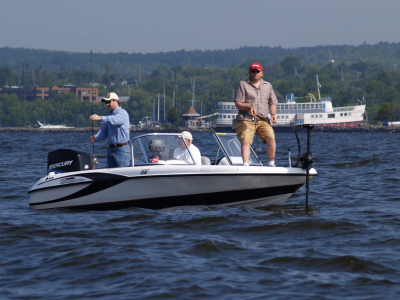The Ontario Federation of Anglers and Hunters (OFAH) wants the provincial government to suspend the commercial gill netting of walleye on Lake Nipissing.
According to the group, it is basing its recommendation on data provided by the Ministry of Natural Resources (MNR). The OFAH’s biologists have concluded that the walleye population has suffered dramatic declines over the past 10 years due to the “unregulated” commercial gill net fishing.
That assumption doesn’t sit well with Jean-Marc Filion, who is president of the Lake Nipissing Partners in Conservation, secretary of the North Bay Anglers and Hunters and vice-president of the Trout Lake Conservation Association.
While he agrees that the fishery is in decline, he points to the invasion of the spiny water flea in the lake.
“The spiny water flea, at the present time, wipes out most of the zooplankton in the lake to a depth of greater than five metres,” he said.
“That is the base of the food chain. If that base is wiped out, then you have a problem with energy flowing up to the top so the lake can’t produce as many fish as it used to in the past.”
Filion has been very involved in lake conservation and has undertaken several studies of lake quality. He published a report in 2010 about the spiny water flea and said the MNR has it and is taking it under consideration.
Filion points out that the Nipissing First Nation, which operates the commercial fishery on Lake Nipissing, has been taking many proactive measures to ensure the longevity of the fishery for all users.
“They stopped gill netting during the spring to give the fish a chance to spawn,” he said.
“They also decided some years ago to look at the maximum number of kilograms the lake can produce and then slash that number by two-thirds, and then only take two-thirds of that.
“They are gill netting in a very conservative way in order to make sure there is enough fish for everyone.
“I don’t think (the OFAH) gave the First Nation credit for what they were doing, and are doing.”
While the OFAH claims the gill netting is not regulated, Filion said the First Nation is managing the harvest. Every net that goes in the lake is numbered and when it comes out, the fish are weighed.
“They know how many kilograms they are taking and they have a quota. When it is reached, they stop fishing. This is painting a very different picture than (we get) from the OFAH.”
Attempts to reach a spokesperson for Nipissing First Nation were unsuccessful.
Due to the spiny water flea, all lake users have to rethink how many fish “we are all taking.”
The MNR has established a committee to look at possible regulation changes and limitations. The OFAH was invited to participate but refused.
“It is very sad they would not come because dialogue is the path to the future,” Filion said.
The OFAH also claims that angler harvest has not contributed to the recent declines of the lake’s walleye since they “have always been regulated,” according to a report on its website.
It does acknowledge that the spiny water flea, an overabundance of double-crested cormorants and climate change may have contributed to declines.
“However, it is important to remember that the continuous overharvest of walleye by the commercial gill net fishery is largely responsible for the declines,” the report stated.
Filion said the lake has managed to sustain a maximum yield of about 90,000 kilograms of walleye.
“Probably now, in today’s ecosystem, it is only a portion of that. What portion, I don’t know.”
The spiny water flea affects all species in the lake but the perch seem to be targeting them and doing well, he said.
Walleye is the top carnivore in the lake, but if its population declines, other species will fill the void, such as perch.
“I am not saying that will happen, but there is a danger here. I really don’t think the OFAH was fair in its assessment and now is the time for dialogue,” Filion said.
Doug Reynolds, executive director of Nature and Outdoor Tourism Ontario, said he is not sure that finger pointing and trying to blame a particular user group is helpful.
“The fishery has been declining, no question about that, but, we need to sit down and find a way forward. It is a complex issue,” he said.
Tourist operators want a solution and Reynolds said the decline of the fishery is one of the many stresses they are facing.
“Lake Nipissing has not been a really high-quality fishery for many, many years. But when there is talk of how bad it is, and it spreads, even people who don’t fish come to think of the lake as not quite the pristine place they thought it was,” he said.
Reynolds said science and visionary leadership are required, and not inward-looking factions who claim they aren’t part of the problem.
Said Filion, “It’s not only about the fishing, but about the ecology.”




